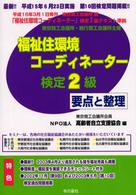- ホーム
- > 洋書
- > 英文書
- > Juvenile Grades 7-9
Full Description
Structured to align with the 2011 VCE study design, Essential VCE Legal Studies Units 3&4 2nd Edition combines compelling and accessible language and layout with genuinely engaging features that encourage students to develop essential skills in legal interpretation, application and analysis. Lead by Kate Ashdown, who is now a practising criminal lawyer, our author team of experienced Legal Studies teachers have created a complete resource package to support and guide students to success in VCE Legal Studies Units 3&4. The bundle includes the student book, study toolkit and Cambridge GO Interactive.
Contents
Units 3 & 4; Introduction; Unit 3: Law-making; Area of Study 1: Parliament and the citizen; Part I: 1.1 Principles of the Australian parliamentary system; 1.2 Structure of the Commonwealth and Victorian Parliaments and roles played by the Crown and Houses of Parliament in law-making; 1.3 Reasons why laws may need to change; 1.4 The Victorian Law Reform Commission; 1.5 Means by which individuals and groups influence legislative change; 1.6 Legislative process for the progress of a bill through parliament; 1.7 Strengths and weaknesses of Parliament as a law-making body; Area of Study 2: The Constitution and the protection of rights; Part II: 2.1 Division of law-making power between state and Commonwealth parliaments under the Commonwealth Constitution; 2.2 Restrictions imposed by the Commonwealth Constitution on the law-making powers of the state and Commonwealth parliaments; 2.3 Process of change by referendum under Section 128 of the Commonwealth Constitution; 2.4 Way in which one successful referendum changed the division of law-making powers; 2.5 Role of the High Court in interpreting the Commonwealth Constitution; 2.6 Significance of two High Court cases involving the interpretation of the Commonwealth Constitution; 2.7 Capacity of the states to refer law-making power to the Commonwealth Parliament; 2.8 Means by which the Commonwealth Constitution protects rights; 2.9 Significance of one High Court case relating to the constitutional protection of rights in Australia; 2.10 Australia's constitutional approach to the protection of rights and the approach adopted in other countries; Area of Study 3: Role of the courts in law-making; Part III: 3.1 Ability of judges and courts to make law; 3.2 Operation of the doctrine of precedent; 3.3 Reasons for interpretation of statutes by judges; 3.4 Effects of statutory interpretation by judges; 3.5 Strengths and weaknesses of law-making through the courts; 3.6 Relationship between courts and parliament in law-making; Unit 4: Resolution and justice; Area of Study 1: Dispute resolution methods; Part 4; 4.1 Reasons for a court hierarchy; 4.2 Original and appellate jurisdictions of the Victorian Magistrates' Court County Court and Supreme Court (Trial Division and Court of Appeal); 4.3 Role of the Victorian Civil and Administrative Tribunal (VCAT); 4.4 Dispute resolution methods used by courts and VCAT; 4.5 Strengths and weaknesses of dispute resolution methods used by courts and VCAT; 4.6 Strengths and weaknesses of the way courts and VCAT operate to resolve disputes; Area of Study 2: Court processes and procedures and engaging in justice; Part 5; 5.1 Elements of an effective legal system; 5.2 Major features of the adversary system of trial; 5.3 Strengths and weaknesses of the adversary system of trial; 5.4 Major features of the inquisitorial system of trial; 5.5 Possible reforms to the adversary system of trial; 5.6 Criminal pre-trial procedures and their purposes; 5.7 General purposes of criminal sanctions; 5.8 Overview of three types of sanctions and their specific purpose; 5.9 Supreme Court civil pre-trial procedures; 5.10 Purpose of civil remedies; 5.11 Types of civil remedies; 5.12 The role of juries; 5.13 Strengths and weaknesses of the jury system; 5.14 Reforms and alternatives to the jury system; 5.15 Problems and difficulties faced by individuals in using the legal system; 5.16 Recent changes and recommendations for change in the legal system; Dictionary; Index.








